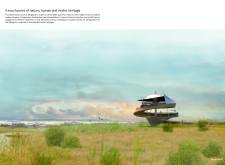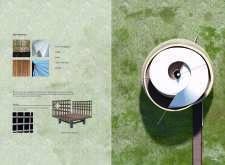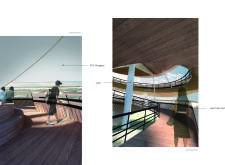5 key facts about this project
The design of the tower is characterized by a spiral form that invites exploration and offers a dynamic interaction with the landscape. Visitors ascend the structure in a gradual manner, allowing them to engage with the environment on multiple levels. Each tier of the tower provides distinct sightlines to the surrounding wetlands, encouraging visitors to appreciate the diverse wildlife and flora that inhabit this unique ecosystem. This thoughtful approach to vertical movement enhances the experience of observation and encourages a deeper understanding of the natural world.
A key feature of the design is its use of local materials and cultural references. The incorporation of traditional elements such as *mashrabiya*, which are wooden lattice screens providing shade while also allowing for ventilation, adds a layer of cultural significance to the project. This design choice not only acknowledges the architectural heritage of the region but also showcases how traditional forms can be reinterpreted using modern materials. The blend of contemporary aesthetics with historical context reflects the project’s commitment to creating a sense of place that resonates with both locals and visitors alike.
The structural integrity of the observation tower is achieved through the use of materials like steel and PTFE fiberglass. These materials are selected not only for their functionality but also for their environmental performance. The lightweight nature of the PTFE fiberglass allows for the creation of a tensile membrane canopy that provides necessary shade to visitors, which is essential in the arid climate of the region. The careful selection of timber for flooring and finishes introduces warmth and a tactile quality that enhances the visitor experience, fostering a sense of comfort in an outdoor setting.
Sustainability is a prominent aspect of the project, as the design emphasizes minimizing ecological impact while maximizing visitor engagement. The architectural approach incorporates passive design strategies, such as natural ventilation and the strategic placement of shading elements, to create a comfortable environment without relying heavily on mechanical systems. This consideration for the local climate reinforces the project’s sustainable ethos and aligns it with similar environmentally conscious architectural endeavors.
Unique design approaches are evident in the overall layout and interaction with the surrounding landscape. The circular path that spirals upward fosters a gradual immersion into the natural setting, contrasting with conventional observation platforms that often focus on singular viewpoints. Instead of merely providing a place to stand and observe, this tower encourages movement, curiosity, and exploration, making the journey as significant as the destination itself.
As visitors engage with this observation tower, they encounter an architecture that is deeply rooted in its environment and culture, inviting them to appreciate the wetlands and the myriad of life forms that call it home. The project stands as an exemplar of how thoughtful design can create spaces that are not only functional but also rich in cultural narrative and ecological awareness. For those interested in understanding this project more profoundly, exploring the architectural plans, architectural sections, architectural designs, and architectural ideas behind the observation tower will provide valuable insights into its design philosophy and execution.


























